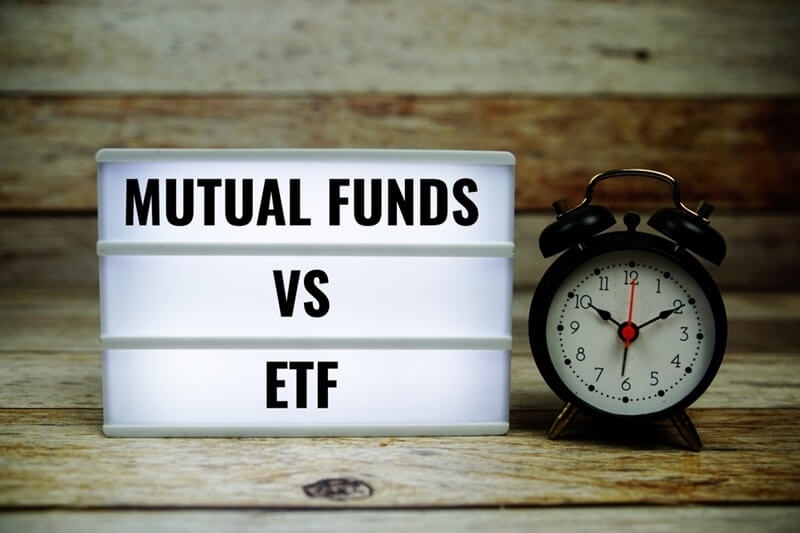
Selecting the appropriate investment vehicle can greatly influence long-term investing and wealth construction. Two of the most popular investment vehicles investors utilize worldwide are Exchange-Traded Funds (ETFs) and Mutual Funds. So, what could you choose between the two? This article is your definitive guide to ETFs vs mutual funds, comparing their characteristics, advantages, and disadvantages, and methods of using them for optimal long-term growth.
Whether you are new to investing and constructing your first portfolio or a seasoned investor taking inventory of your holdings, knowing the ETF vs. mutual fund comparison is critical in making investment decisions.
ETFs and mutual funds are investment vehicles that aggregate money from many investors to purchase a range of investments, typically stocks or bonds, but can be commodities, indexes, etc. ETFs and mutual funds provide a simple way to gain diversification without picking and purchasing stocks or bonds one at a time. Despite the two types having similar characteristics and overall benefits, the two investments have several key differences.
Understanding the structural differences between ETFs and mutual funds is an important first step in making the right choice when selecting the best investment vehicles for your long-term investment growth!

Let us dissect this ETF vs mutual fund comparison in areas that matter most to investors.
Winner: ETFs for flexibility and real-time pricing.
This is a critical point in the concept of fund fees vs returns. Even over time, small fee changes can accumulate in meaningful differences as you chip away at your potential returns.
Winner: ETFs for cost productivity.
In the debate on tax efficiency, ETFs vs mutual funds have a clear structural advantage for taxable brokerage accounts.
Winner: ETFs for tax-conscious investors.
Winner: ETFs for accessibility, especially for beginners or small investors.
Depending on your investing goals, the best ETF mutual fund mix may include passive ETFs and select actively managed mutual funds.
Winner: Tie – depends on your strategy.
Winner: ETFs for transparency.
Your cost is one of the most significant long-term determinants of your investing success. Fees can compound in reverse, meaning the higher your expense ratio, the more you lose over time.
Let’s illustrate with a hypothetical example:
| Fund Type | Expense Ratio | Investment | 30-Year Return (Hypothetical) |
| ETF (Low Fee) | 0.05% | $100,000 | $432,000 |
| Mutual Fund (High Fee) | 1.0% | $100,000 | $332,000 |
In this scenario, the difference between the ETFs vs mutual funds fee leads to a $100,000+ difference in ending value. Always compare fund fees vs returns before investing.
For many investors, the smart strategy isn’t choosing ETFs or mutual funds exclusively but finding the right combination to match their goals.
| Asset Type | Fund Type | Allocation |
| U.S. Equity | Low-cost ETF | 40% |
| International Equity | Mutual Fund | 20% |
| Bonds | ETF | 25% |
| Real Estate/REITs | ETF | 10% |
| Thematic/Active Ideas | Mutual Fund | 5% |
This diversified setup leverages the best ETF mutual fund mix by combining low-cost ETFs with high-conviction mutual fund strategies for long-term growth.
Regardless of the vehicle you choose, your goal is long-term capital appreciation. Here's a checklist from a long-term growth fund guide to help you evaluate any ETF or mutual fund:
Remember, past performance does not guarantee future results, but it is still valuable context.
Whether investing in ETFs or mutual funds, be cautious of:
When in doubt, prioritize simplicity, clarity, and long-term alignment over flashy marketing or trends.
So, what’s the final word on ETFs vs mutual funds for long-term growth?
Ultimately, there is no one-size-fits-all answer. Your best investment vehicle depends on your goals, tax situation, account type, and investing style.
Deciding between ETFs and mutual funds is a big step, but just one step in your financial journey. The secret to long-term investing success is staying invested in a diverse plan, reducing costs and taxes, rebalancing as required, and remaining invested through the market's ups and downs.
When you learn how to deploy ETFs and mutual funds successfully, you put a powerful tool to work to grow your wealth for decades to come.
This content was created by AI